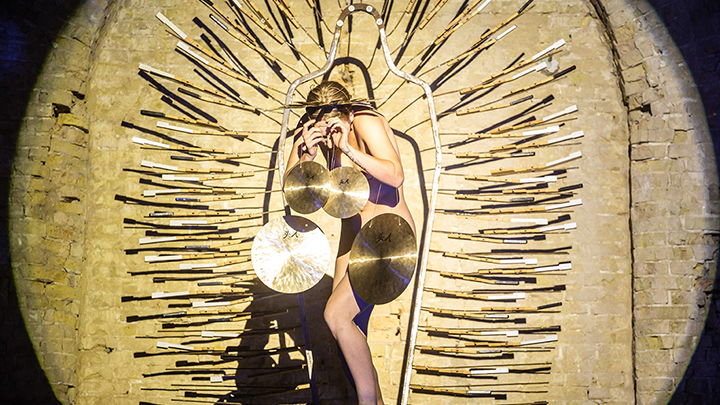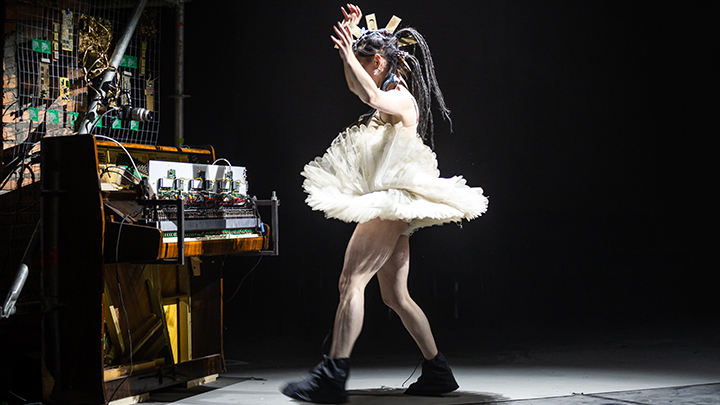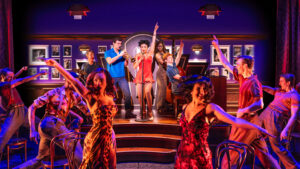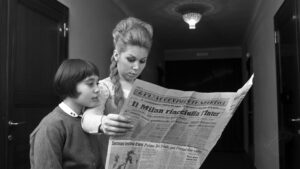With their banners, the opera-crashers raised a question worth asking: what is the place of opera, that centuries-old and ever evolving art form, on a planet that seems to be hurtling unchecked towards climate calamity? Now at La MaMa as part of the Prototype Festival, Chornobyldorf: an Archeological Opera in Seven Novels offers an answer to this question; the piece, by Ukrainian composer-directors Roman Grygoriv and Illia Razumeiko, is a hypnotic, anarchic, imagined funeral rite for a dead planet’s living medium.
Chornobyldorf was, as its subtitle promises, structured as a series of seven vignettes that coupled live performance with moody, evocative video art by Dmytro Tentiuk. All seven of the piece’s segments were staged with the obliqueness of unapologetically experimental performance art, but all contributed discernibly to the show’s basic premise: a post-apocalyptic society re-approaching and re-appropriating the relics of our own, long-dead world and its artistic forms.
This premise resembles the Anne Washburn play Mr. Burns, a post-electric play, in which the survivors of nuclear catastrophe create cultic rituals from half-remembered episodes of The Simpsons. But where Washburn eased the audience into this concept via a plot structure that moved sequentially from post-disaster realism to post-electric surrealism, Chornobyldorf plunged immediately into its antic, radioactive fantasia.

The signs and sounds of classical music and theater recurred in Chernobyldorf, but were always presented as slightly off: begowned singers might duet à la bel canto, but they were also liable to open their mouths and produce only screams, gasps, and croaks. Costumes by Kateryna Markush combined monkish robes, crushed velvet dresses, and Eastern European folk dress with braided crowns of fiber-optic cables and collars of wire. On the video screen, dancers in hoop skirts, framed by red velvet curtains, writhed as though in their death throes. Onstage, those same dancers leapt gleefully in and out of roving spotlights to the relentless pulse of a dulcimer played with a pair of drumsticks.
This hammered pulse was the beating heart of Chornobyldorf, emerging in a clamorous throb from a dulcimer, a bandura, a cello, various synthesizers, and a slew of bizarre instruments created by designer Evhen Bal. Woven into and around this propulsive rhythm were recurring textures of scraping, creaking, and sliding, as Grygoriv and Razumeiko bowed microtonal swathes of sound from the dulcimer and bandura. The vocal lines likewise took up this interest in the sounds that occur around the edges of the normative, with singers gasping, throat-singing, and croaking out a distinctive vocal fry sound that resembled not only the scrape of bow on bandura but also the crackle of a Geiger counter.
More traditionally sung material ranged from blasts of choral and operatic sound to folk songs sung in the Eastern European “white voice” style. White voice is characterized by loud, bright, incredibly straight-toned sound that pours from singers’ open throats; when, in Chornobyldorf, two singers duetted in this style, the piece’s recurring motif of slipping in and out of tonal alignment was at its most compelling. The two voices kept snapping into a unison in which it was nearly impossible to distinguish that I was hearing two voices and not one. Then, one voice would slowly slide up or down against her partner’s drone, creating an eerie effect of melodic decay.
A musical highlight of the piece and one that demonstrated the pleasure it seemed to take in combining and recombining musical styles was a setting of “Ave Maria,” sung first in a Ukrainian folk style, then in a choral style, and then as screamo, bellowed over a bone-rattling bass synthesizer.
Indeed, I was struck throughout by Chornobyldorf’s palpable sense of pleasure—a feeling that despite the weightiness of the show’s premise, the work remained invested in playfulness. Segments in which, for example, a dancer in a white tutu and heavy boots bounded gracelessly to a piano played by robotics, or in which three performers wore accordions turned ninety degrees, so that the bellows hung down vertically and the instruments could be played by bouncing up and down, seemed to explore the idea that rediscovering fragments of lost art forms could mean having fun with what you find.
Elsewhere, the piece took a less playful and more accusatory view of the world left behind to become Chornobyldorf: the world of opera, of theater, of nuclear reactors, and of fossil fuels. A segment entitled “Orfeo ed Euridice” presented the piece’s core confrontation with opera’s history and legacy. In this sequence, the show’s company split into two choruses to trade, a cappella, eerie vocal lines, wails, and ululations. Then, the show’s female performers laid one of the dancers out on a table and began, as if performing Euridice’s burial rites, to anoint her naked body with oil. Meanwhile, to cacophonous instrumental accompaniment, another performer delivered the show’s only significant English text: an invective against Euridice—the character, the concept, the woman on the table, the opera, or some combination thereof. “Euridice, you are nobody,” he cried, “a new opera for an old world.”
Here, Orfeo ed Euridice—a cornerstone of opera’s own creation myth—was recast as the exorcized ghost of a long-dead world, promising a lineage of artistic evolution that nevertheless ends, like all things, in destruction. There is, after all, no opera on a dead planet. On the other hand, there will certainly be more opera to come on this planet, not quite dead but certainly in danger, and pieces like Chornobyldorf allow us to confront both the fear of that danger and the pleasure of art’s potential resilience. Perhaps we can hope that if there is any opera at all for us to rebuild from the ashes of this world, it will look something like Chornobyldorf.
Photos: Artem Galkin








Comments